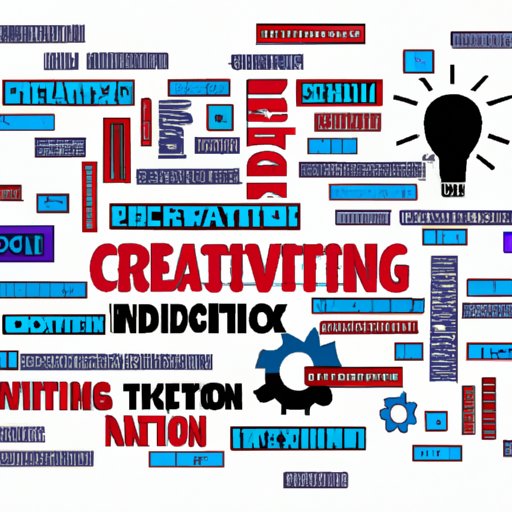Introduction
Creativity is often thought of as something that only artists or those in creative fields possess. However, the truth is that everyone can be creative – and there are a number of ways to tap into your own unique brand of creativity. In this article, we will explore what creativity is, looking at different definitions, how it is applied in everyday life, and the various benefits it can bring. We will also examine creative thinking techniques and strategies, as well as the role of creativity in education and technology.

Exploring the Definition of Creativity
The definition of creativity is often debated, with many experts having their own interpretations of what it means to be creative. According to psychologist Mihaly Csikszentmihalyi, creativity is “the process of making something new and useful”. Creative activities can range from writing a novel to finding innovative ways to solve everyday problems.
Dr. Teresa Amabile, an expert on creativity and professor at Harvard Business School, defines creativity as “the production of novel, useful ideas”. She further explains that creativity involves the ability to come up with new ideas, perspectives, and solutions, as well as the capacity to put them into action.
Creative activities don’t have to involve art or music; they can also include problem-solving, design, and even cooking. Everyone has the potential to be creative, but it may take some effort to uncover and nurture your own unique capabilities.
Examining Creative Thinking Techniques
Creative thinking techniques can help you to think outside the box and come up with new ideas. Brainstorming is one of the most popular techniques, which involves generating ideas without any limitations or judgement. The goal is to come up with as many ideas as possible – regardless of whether they seem practical or not.
Another technique is mind mapping, where you draw a diagram to represent your ideas. This can help to organize your thoughts and make connections between different concepts. Other thinking strategies include freewriting, where you write down your thoughts without worrying about structure or grammar, and lateral thinking, which encourages you to look at things from a different angle.
Investigating Creative Problem-Solving Strategies
Creative problem-solving strategies can help you to come up with innovative solutions to everyday challenges. One of the key steps is to identify sources of creative ideas. This could include gathering information from a variety of sources, such as books, articles, and conversations with other people.
Once you have gathered enough information, you can then analyze possible solutions. This involves breaking down the problem into smaller components and looking for patterns and relationships. From there, you can develop a plan of action that takes into account potential obstacles and risks.

Analyzing the Benefits of Creativity
Creativity can bring a number of benefits, both personally and professionally. On a personal level, it can help to boost your self-confidence and sense of accomplishment. Studies have also found that creative activities can improve mental health, reduce stress, and increase feelings of wellbeing.
On a professional level, creativity can help you stand out from the crowd. Employers are increasingly seeking out individuals who can think outside the box and come up with creative solutions to problems. Creative thinking can also help to foster collaboration and innovation in the workplace.

Defining the Role of Creativity in Education
Creativity has an important role to play in education. It helps to foster critical thinking, problem-solving skills, and the ability to think outside the box. Many schools are now focusing on developing these skills in students, encouraging them to explore new ideas and express themselves in creative ways.
Creativity is also playing an increasingly important role in curriculum development. Schools are embracing the use of technology to create more engaging learning experiences, while also incorporating creative activities into traditional subjects such as math and science.
Investigating the Impact of Technology on Creativity
Technology has had a huge impact on creativity, offering tools and platforms that can help to bring ideas to life. Digital tools such as video editing software and 3D printing can help to bring creative projects to life in ways that were previously unimaginable.
At the same time, some experts argue that too much reliance on technology can stifle creativity. This can happen when people become so focused on the technology itself that they forget to think creatively about how to use it. It is important to strike a balance between using technology to enhance creativity, and relying too heavily on it to do the work for you.
Conclusion
In conclusion, creativity is the process of making something new and useful. It is an essential skill that can be developed through creative thinking techniques and problem-solving strategies. There are numerous benefits to being creative, both personally and professionally. It also has an important role to play in education, and technology can be used to enhance creativity if used appropriately.
If you are looking to tap into your own creativity, there are a number of resources available online to get you started. These include courses, tutorials, and books that can help to unlock your creative potential.
(Note: Is this article not meeting your expectations? Do you have knowledge or insights to share? Unlock new opportunities and expand your reach by joining our authors team. Click Registration to join us and share your expertise with our readers.)
